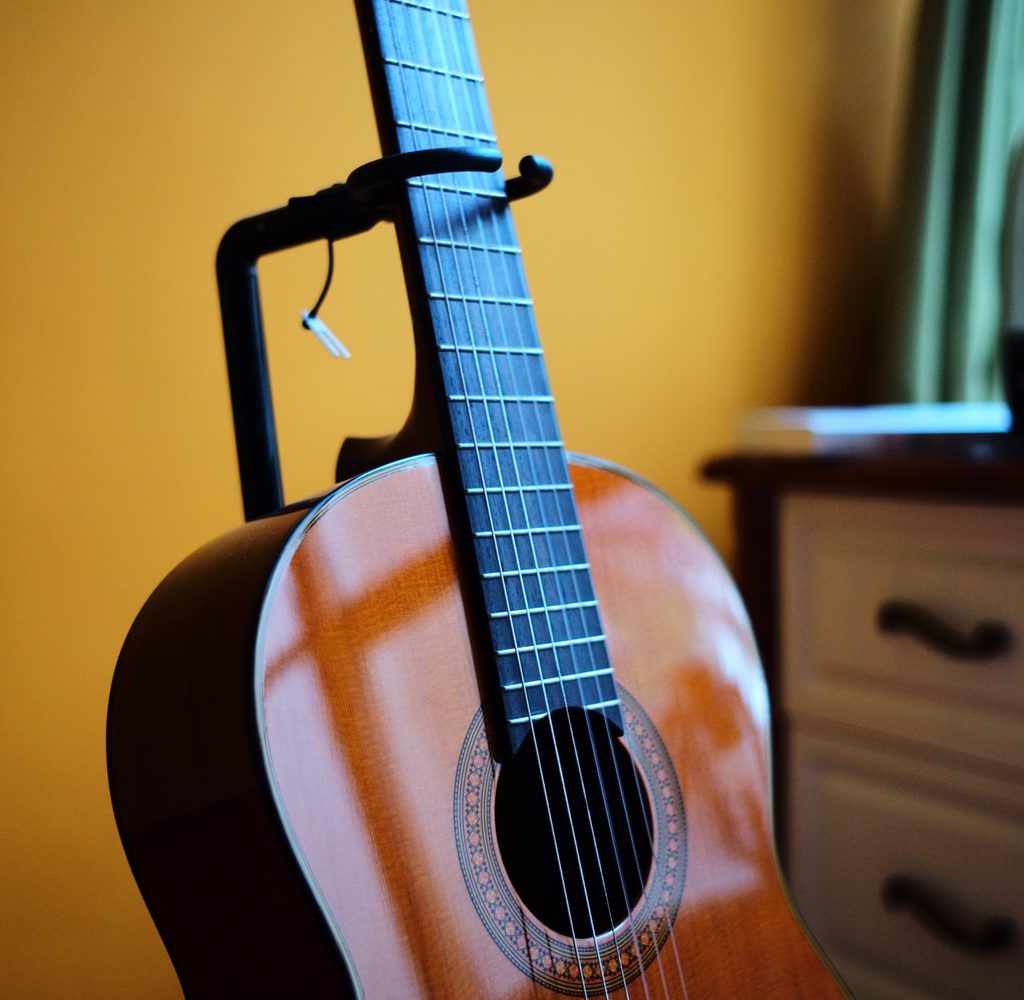Now that you have learned to play a few chords on the guitar, the next step is to write a melody of your own. With this article, we will be your guide to successfully writing a wonderful melody.

Photo by Kenny Luo on Unsplash
To write a melody, you need to first understand what a melody is. A melody is a sequence of single notes that are played one after the other.
Now, let us look at a few simple steps that would set you on your way to creating a basic and beautiful melody using stuff you are already familiar with.
Step 1 – Select a few chords
Step 2 – Come up with a picking order
Step 3 – Pick a beat count
Select A Few Chords
By now, you should already be familiar with a few chords on the guitar, these chords will be your stepping stone to creating your first melody.
One of the easiest ways to create a simple melody is to hold a chord, and then, instead of striking all the strings at the same time, you pick them one at a time.
So, to create your first simple melody, select a few chords you already know, and enjoy playing.
How To Come Up With A Picking Order For A Melody
Picking order is the order your strings are picked, pretty simple. For this step, there is no general way to do it. This is because the picking order you use is dependent on the chord(s) you decide to use.
When creating your melody, you could use just one chord and strike each string with different picking orders and still create something cool.
Although there are no general hacks, there is one thing that is important when choosing a picking order, and it involves the notes in the chords you are playing.
For your melody to sound pleasant, your picking order needs to be arranged in such a way that the notes in the chord or chords complement each other.
How To Pick A Beat Count For A Melody
The beat count is what determines the speed of your melody. For your first melody, we advise that you don’t select a beat count that is too fast as this could make the work a little more complex for you.
So, don’t do something too fast so you don’t over push yourself, and not something too slow so you don’t get bored.
Once you have selected the beat count that works best for you, then you can align your picking order with the beat count.
With these three simple steps, you are well on your way to writing a melody of your own.
Check out these other articles
- How to set up an electric guitar
- What do guitar pedals do?
- How to practice guitar
- How to solo on the guitar for beginners
- How to pack a guitar for shipping
- What is an acoustic guitar?
Conclusion — How To Write A Melody On The Guitar

Photo by Edward Eyer on Unsplash
Before we leave you, it is important that we mention that the most important tool for you when creating a melody are your ears.
The chord you decide you use, your picking order, and beat count that you decide to use all depend on what sounds the best in your ears.
So, when creating your melody, try as much as possible to stay original and make music that sounds good to you first.
Finally, we leave you with a video showing a few tips and ideas for creating your own melody.
How To Write A Melody On The Guitar – Frequently Asked Questions
How do you do melody chords?
A chord melody is an arrangement in songwriting where both the chords and melody are included simultaneously. The melody is practically the most important element of a chord melody arrangement.
There is a simple way to do chord melodies. Learn to harmonise the melody of your choice with different flavors of chords. This includes using inversions, extensions and substitutions. Break things apart by playing the chord before or after the melody to give it movement.
How do you play a guitar melody for beginners?
The best approach for beginners is to stay with the melody of a song they know very well. Find the root of the song or the first note of the song. You could sing along with the first note of the song and then try to find its matching note on the guitar.
Once you have identified the root note start to pluck out the rest of the song from memory as you play on the guitar. Occasionally you can turn on an audio of the song to compare what you are doing. You need to be deliberate about your practice until you have mastered the melody.
What is the relationship between chords and melody?
Chord tones give melodies a sense of stability and release that you normally will not get with melodies that do not have chord tones. Melody without chord tones seemingly leaves your music with a sense of momentum and tension. Hence, chord tones and melody go hand-in-hand. Too much of one over the other leaves your music either chaotic or boring. A balance between chord tones and melody is therefore required.
How do you play a guitar chord and melody at the same time?
If you already have guitar chords and you want to add some melody, first figure out the right key. This involves matching the notes in your chords to a key where those notes are possible. This allows you to play in that key. Attempt to move within this key while following the chords. Make attempts to deviate from the chords whilst trying to make it sound good. Writing melodies like this is often experimental as there is no conventional way to do it.
What makes a melody catchy?
There are a number of elements of a melody that could make a melody catchy and difficult to get off your head.
Scientifically speaking, it might be difficult to pin-point what makes a song catchy. But taking a closer look at many catchy songs of the day, there are recurring elements in these songs. One of such is repetition. Others could be hooks or alliteration. Repetition is apparent in popular songs like Empire State of Mind by Jay-Z and Alicia Keys. The use of alliteration is apparent in Black Eyed Peas’ single ‘Boom Boom Pow’
What is a hook in a song?
A hook is oftentimes the most catchy part of a song. Traditionally, it is a riff, a passage or phrase specifically designed to appeal to and catch the attention of the listener. Music hooks are a catchy combination of melody, rhythm and lyrics designed to stay in the head of a listener to ‘hook’ them to the song. Many times the hook is written to be the chorus of the song, but this is not always the case.

Pingback: How To Read Guitar Tabs For Dummies - Classical Guitar Works